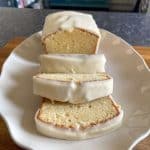Sour Cream Pound Cake With Vanilla Bean Icing
This sour cream pound cake is rich, buttery, moist and full of flavour. Finished with a thick vanilla bean icing, it really is hard to beat!
Servings: 8 Slices
Equipment
- 2 lb Loaf Tin
- Stand Mixier
- Sieve
- Piping Bag
- Wire Cooling Rack
- Mixing Bowl
- Palette Knife
Ingredients
Sour Cream Pound Cake
- 235 g Caster Sugar
- 1 Lemon (Zested)
- 190 g Softened Unsalted Butter (Plus Extra, For Greasing The Tin)
- 4 Large Eggs
- 250 g Plain Flour
- ½ tsp Table Salt
- ½ tsp Baking Powder
- 130 g Sour Cream (At Room Temperature)
- 1 tsp Vanilla Extract
To Pipe On Top (Before Baking)
- 20 g Softened Unsalted Butter (In A Piping Bag)
Vanilla Bean Icing
- 150 g Icing Sugar
- 125 g Double Cream
- 1 tsp Vanilla Paste
Instructions
Sour Cream Pound Cake
- Preheat an oven to 175°c/155°c fan (350°f/310°f).
- Grease a 2 lb loaf tin with butter then line the bottom & two longer sides with a piece of baking parchment, leaving a couple of centimetres overhanging the tin's edges (this makes it easier to take the cake out of the tin once it is cooked!).
- Sieve the flour, salt & baking powder into a bowl then set aside.
- Next, add the caster sugar & lemon zest into the bowl of a stand mixer (with the paddle attachment attached). Rub the zest into the sugar with your fingers then add in the softened butter.
- Cream the butter & sugar together on a medium speed, until pale & fluffy. This will take at least 5 minutes. Make sure to scrape the sides of the bowl down regularly with a spatula!Once creamed, the butter should be white in colour.
- Add the eggs into the butter, one at a time, with the mixer still running on a medium speed. Once all the eggs have been added, give the bowl another scrape down then mix again for a minute.
- Next, add half of the sifted flour into the butter & gently fold in with a spatula, until just combined. Add in the remaining flour, the sour cream & vanilla then fold again, until just incorporated.Be careful not to over mix!
- Transfer the cake batter into the lined loaf tin, spreading it out with a spatula, into an even layer.
- Pipe a thin line of softened butter straight down the middle of the cake then bake in the preheated oven for 50 minutes - 1 hour, until golden brown & a skewer inserted into the centre comes out clean.Piping butter down the middle of the cake lets us control how the top of the cake cracks as it bakes - this is optional though! If your cake starts to brown too much towards the end of the bake, cover the top loosely with foil.
- Once your cake is cooked, let it cool in the tin for 20 minutes then run a small palette knife along each end & carefully lift it out of the tin (using the overhanging parchment) & transfer to a wire cooling rack, to cool completely.
Vanilla Icing
- Sift the icing sugar into a mixing bowl then add in the double cream & vanilla paste. Whisk together, until thick & smooth.
- Spoon the icing over the cake then leave to set in the fridge for 30 minutes before serving.
Notes
1. Baking In An Aga - Bake the pound cake on a grid shelf placed onto the floor of the baking oven. Slide a cold plain shelf onto the top set of runners just before baking the cake, leaving it in for the duration of the cook.
2. Loaf Tin - You'll need a 2 lb loaf tin for this pound cake recipe. The tin should roughly measure 9" x 5" x 2.5". To prevent the cake from sticking, I'd recommend lining the base & two longer sides with a piece of baking parchment, leaving a couple of centimetres overhanging. This acts like a sling, making it easier to remove the cake once it is baked. Make sure to grease each end with butter, as well.
3. Room Temperature Ingredients - For a properly mixed cake batter, it's important that the butter, eggs & sour cream are all at room temperature. The butter should be soft but not melted!
4. Piping Butter On Top - Piping a thin line of soft butter down the middle of the cake before baking it, allows us to control where the top of the cake will crack as it bakes. This is optional though!
5. Icing - Make sure to let your cake cool completely before icing, otherwise the icing will melt! The icing should be thick but still spoonable. If your icing is too thick, add in more double cream and if it's too thin, add in more sifted icing sugar.
6. Storage - As our icing contains double cream, it's best to store the cake in the fridge. Kept in an airtight container, it will keep for 3-4 days. Make sure to let it come up to room temperature before serving or give it 10 seconds in a microwave.
